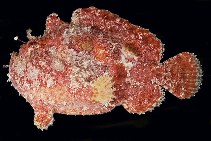|
Abantennarius coccineus (Lesson, 1831) Scarlet frogfish |

|
|
photo by
Randall, J.E. |
| Family: | Antennariidae (Frogfishes) | |||
| Max. size: | 13 cm TL (male/unsexed) | |||
| Environment: | reef-associated; marine; depth range 10 - 75 m | |||
| Distribution: | Indo-East-Pacific: Red Sea and East Africa to the easternmost islands of the Pacific Plate (Ref. 6773), including the Desventuradas Is. (Ref. 89357). | |||
| Diagnosis: | Dorsal spines (total): 3-3; Dorsal soft rays (total): 12-13; Anal spines: 0-0; Anal soft rays: 7-7. Color variable, usually yellow, red or pale tan, often with a weakly pigmented dark spot at posterior dorsal fin base. Illicium about equal to the length of the 2nd dorsal spine. Esca a spherical whitish blob or it may be filamentous. Last ray of pelvic fin bifurcate. Caudal peduncle absent. Description: Characterized by unbranched pelvic rays except posterior most; curved second dorsal spine, not connected to head by membrane; depressed naked area between second and third dorsal spines; dorsal and anal fins ending at base of caudal fin (Ref. 90102). | |||
| Biology: | Collected from tide pools as well as lagoon and seaward reefs (Ref. 1602); secretive among rocks and sponges (Ref. 48635). Feeds on small fishes (Ref. 89972). Benthic (Ref. 58302). Oviparous. Eggs are bound in ribbon-like sheath or mass of gelatinous mucus called 'egg raft' or 'veil' (Ref. 6773). Found among reef crevices or among rubble in 1-75 m, but usually less than 10 m (Ref 90102). | |||
| IUCN Red List Status: | Least Concern (LC); Date assessed: 06 September 2021 Ref. (130435) | |||
| Threat to humans: | harmless | |||